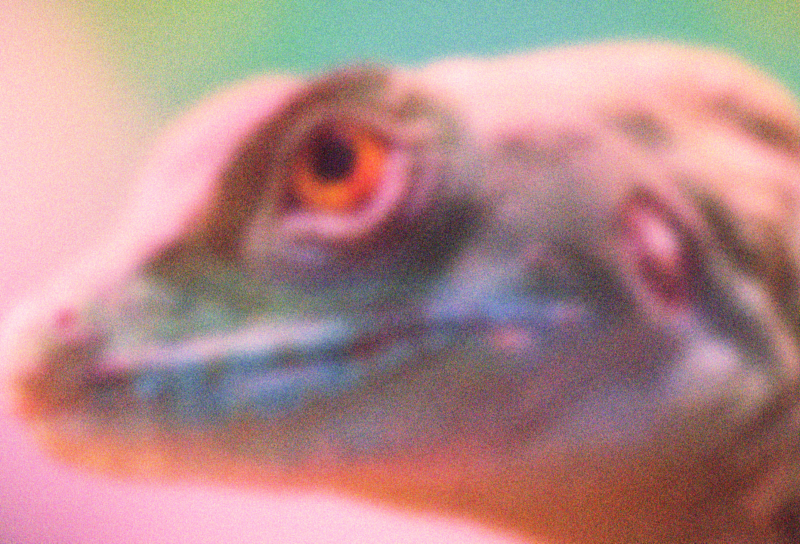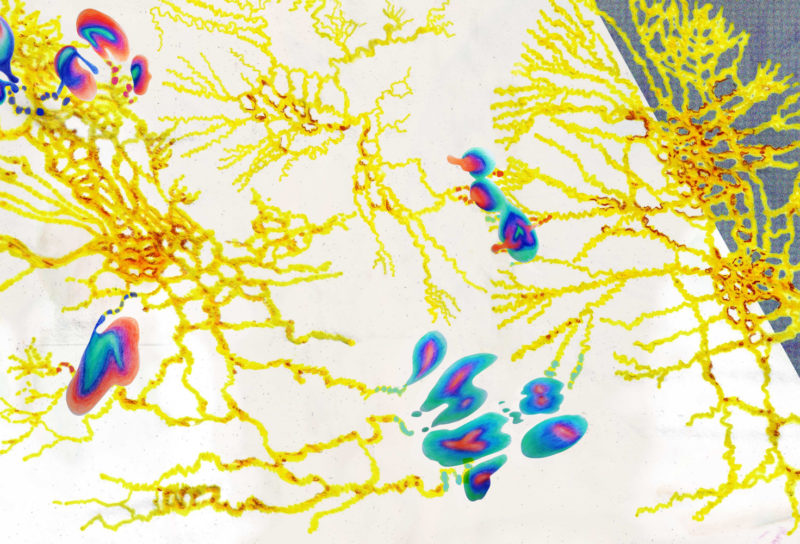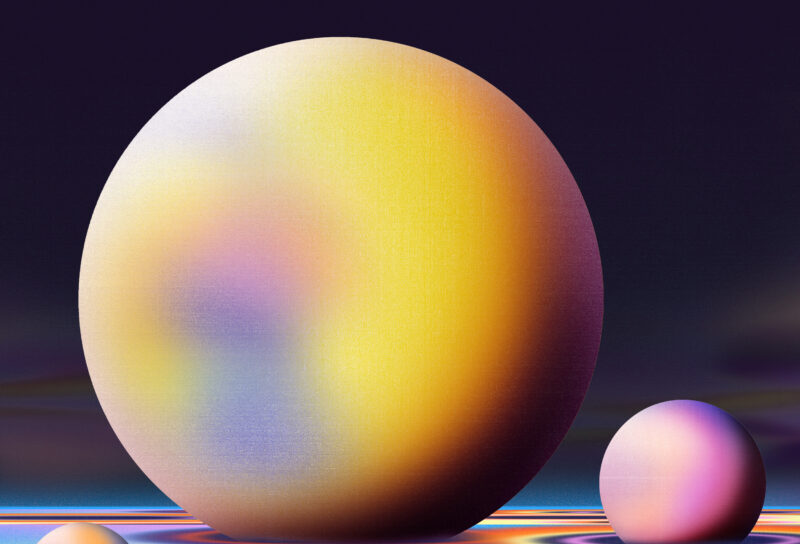Greta is photographed hundreds of times before she can fully open her eyes. This fact eludes her, of course. All she can make out through the walls of her tank are the fluttering white suits of her creators.
The room is bright and her bath is warm. A clamp slides over her sides. She squeals as it hoists her up, her trunk and feet gliding along the plastic walls. The temperature drops as she is pulled through a narrow rubbery slit. Adjusting well to the cold air, she suddenly feels alien hands patting her down. A grinning being approaches her, white fluff all around its face. Is this her mother? Instinctively, she reaches out with her trunk, but recoils upon feeling its starchy lab coat. Greta feels disoriented and confused. She is longing for something, but she doesn’t know what.
They finally walk her out of the lab, down a long bright hall, but then she hears the echo of the crowd, the squeak of the microphone. She shuts her eyes and curls into a ball. The cameras flash and snap at her. Greta tries to tear away, but realizes that she is bound by invisible leashes. She trembles fiercely and trumpets wildly, a temper tantrum broadcast all over the planet. Where are her parents? Who are these grinning beings all dressed in white? What are they planning to do to her?
Everything goes blurry. Weeks pass with every slow blink. Her captors introduce her to other animals that look similar to her, albeit without all the fur. Unfortunately, her elephant cousins gather that there’s something strange about Greta. They snort at her and keep their distance.
Her first pleasant memory will be her little brother’s arrival in her pen. Bill (named after another climate advocate) is hairy, too, misshapen in a different way. Soon, the two of them are joined by more and more lost souls of their kind. A few months later, this listless gang, who the white coats affectionately nickname their “climate marchers,” are moved to a big outdoor pasture in Siberia called Pleistocene Park. Here, anxious Greta enjoys her first spell of relative stability. It is a comfortable temperature, and though she’s still confused and afraid, at least her brothers and sisters feel the same. Unaware of the human hopes on their shoulders, they trample around all day in the snow, looking for blades of grass to eat.
Does Greta have any idea who she is? Does she feel any connection with her distant ancestors, the wooly mammoths, who roamed the same steppe more than 12,000 years ago?
Greta’s Parents
The scientific project that may make our hypothetical friend Greta a reality is currently underway at Harvard University, supervised by renowned inventor of genetic technologies George Church. His team’s goal is not to bring woolly mammoths back to life, per se, but to engineer mammoth–elephant hybrids. To that end, they have taken Asian elephant cells and edited woolly mammoth DNA sequences into them using the gene-editing tool known as CRISPR. These are the first steps to making an elephant with thicker hair, fattier insulating skin, smaller ears that allow less heat to escape, and the ability to bind and release oxygen in blood at freezing temperatures.
The woolly mammoth and Asian elephant are believed to have about 1.4 million specific genetic differences between them. That might sound like a lot, but when the entire genome is made up of several billion bases, it’s mere pocket change. Editing important differences away may yield a cold-tolerant elephant, expanding the range of where today’s elephants can live. In this sense, it’s a high-tech approach to elephant conservation.
But why create a Greta when they could just do a better job at helping today’s elephants thrive in the wild? Greta, too, may wonder about the point of it all. Her creators say their dream is to resurrect, not a species, but an entire ecosystem. And the productivity of the woolly mammoth’s former ecosystem, they say, needs to be revived to stave off a climate catastrophe far worse than the one we already face.
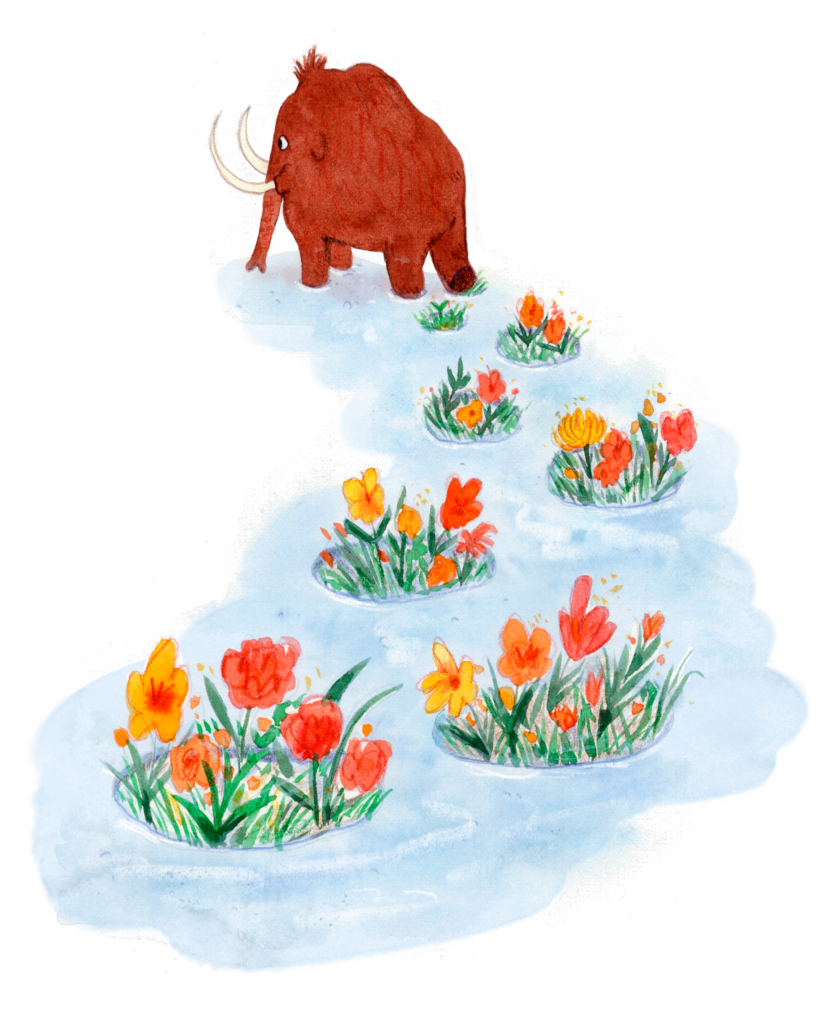
The Lost World
Walking in the footsteps of her ancestors — whose population crashed over 12,900 years ago, but who continued to survive on certain islands until 3700 years ago — Greta’s trunk rifles through decomposing plants, looking for a blade of grass to eat on a cold winter day. Her hairy foot punches through a crusty top layer of snow. Her hip bows out to the side with a forceful thrust, toppling over a tree stump. A mountain of shit rains down to the ground, where grasses will soon grow. Whether she knows it or not, Greta is a geo-engineer with an urgent task.
The mammoth steppe ecosystem dominated the Arctic in the late Pleistocene and spanned Europe, northern Asia, and northern North America. It’s been estimated that there were once one mammoth, five bison, six horses, and ten reindeer for each square kilometer in some parts of the steppe, with an extra smattering of muskox, elk, woolly rhinos, saiga antelope, snow sheep, and moose. Grasses dominated the land thanks to the animals’ constant grazing, while most of the trees and shrubs were trampled under their hooves and feet. But as the climate changed and the number of human hunters increased, the megafauna started to disappear, as well as the productive ecosystem they maintained.
There are currently about 1500 billion tons of carbon trapped in permafrost in the mammoth steppe, which is twice as much as what is currently in the atmosphere. The carbon from plants and animals that died thousands of years ago is not dangerous in itself, but its decomposition would be. When carbon-rich organics are exposed to the elements, bacteria chew away at the stuff, producing either carbon dioxide or methane, two greenhouse gases. Released into the atmosphere, they accelerate global warming, which is why thawing permafrost is increasingly talked about as a ticking time bomb.
That’s where Greta comes in. Russian scientist Sergey Zimov, who runs Pleistocene Park, believes that the best way to keep the carbon locked up in the permafrost is to restore the ecosystem that thrived there during the Pleistocene. At that time, the area was covered with rich grasses, which reflected light from the sun. As the large animals grazed all day, they trampled other, darker light-absorbing plants and carved holes in the snow with the force of their feet.
The three-foot layer of snow that lays on the ground of the mammoth steppe today for much of the year might be seen as an insulation blanket. It keeps what’s beneath warmer than what’s on top. If the outside temperature is –40 degrees Celsius, then it might only be –5 or –10 Celsius under the snowy layer. But when millions of feet are punching holes in the snow, as they once did during the Pleistocene, that insulating blanket is perforated and cold air is pumped into the ground. Woolly mammoths oversaw a ventilation system, according to this theory. The air circulation they caused with their heavy footsteps kept things cool; the stumps and plants they’d destroy reduced the amount of heat-absorption from dark vegetation; and the lighter grasses they’d fertilize with their dung would reflect the sun’s rays.
That’s why George Church and his team at Harvard want to create a herd of 80,000 Gretas, and send them to Siberia.
The Trouble with Elephants
Their work is well underway, but the outcome is still speculative. As Bobby Dhadwar, a former post-doc in the Church Lab who did a lot of the initial gene-editing work, says, “When people hear about it, I think they get confused on the timescale. It’s not like we are anywhere close to giving birth to a woolly mammoth.”
One hurdle they must overcome is how they’re going to source eggs from Asian elephants. Female elephants ovulate every sixteen weeks, although they can also skip years of ovulation during pregnancy and lactation. In most animals, it is possible to use an ultrasound to locate the follicle where the egg is developing, and harvest it from their ovaries.
But that’s not so easy with elephants. Turns out, it’s notoriously hard to navigate an elephant’s vaginal opening. Females have more than a few feet of canal, called a vestibule, between their vulva, where any instrument would enter, and their hymen. Another problem is that the elephant hymen remains intact even after it has intercourse. Though it ruptures when a female gives birth, it grows back after each pregnancy. Sperm can reach the egg only by passing through a tiny aperture in the membrane.
With artificial insemination tools, researchers have been able to get sperm through that tiny opening, but to actually get an egg out, they must navigate an enormous depth on the other side until they locate the egg-producing follicle — too deep for an ultrasound to visualize by itself. Laparoscopic surgery, in which operations are performed through small keyhole incisions, can help when the follicle is so hard to reach. The process typically requires that the animal’s abdomen is inflated to allow for better visualization of the internal structures. But inflating the abdomen of an elephant could kill it, since elephants lack a pleural cavity (the space between the squishy membranes that surround the lungs and line the inner chest), which makes inflation harmless in other animals. The elephants’ chest cavity could easily become overcompressed. As a result, researchers are hoping for a breakthrough in embryogenesis — the creation of embryos — to make this work.
The technical complexity doesn’t stop there. If they one day manage to insert all of the desired mammoth DNA into a fertilized elephant egg cell, they will then have to put it somewhere it can develop. Elephants are having a hard enough time reproducing in the wild as it is, so Church’s team has tentatively rejected the idea of using real elephants as surrogates.
Instead, they are working towards using artificial wombs. Ectogenesis, a term coined by British biologist J.B.S. Haldane in 1924, refers to the growth of an organism in some sort of vessel outside of the body. In the 1990s, Japanese researchers came up with a technique called extrauterine fetal incubation. They connected catheters to large blood vessels in goat umbilical cords, and fed oxygenated blood to the fetuses as they grew in tanks of amniotic fluid, which were heated to a goat mother’s normal body temperature. Getting all the technical components of mammoth de-extinction right will take years, if not decades.
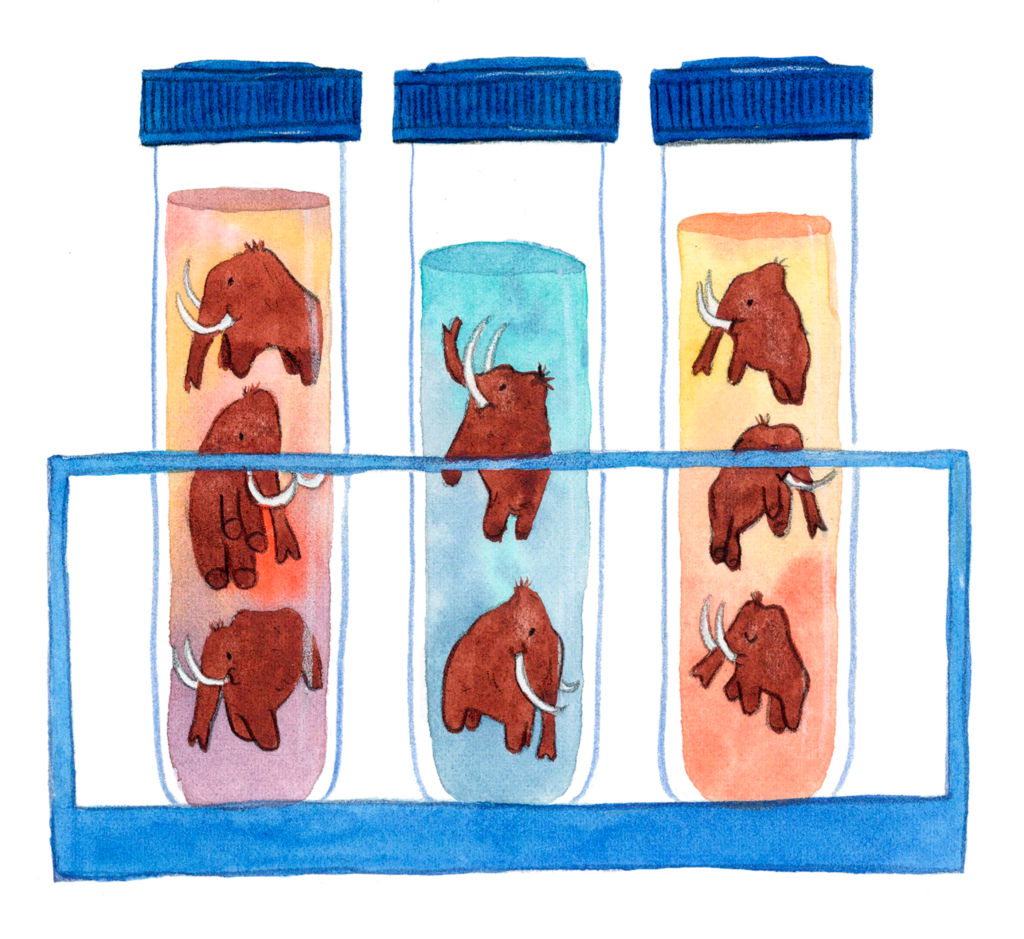
But this isn’t really about her, anyway.
Growing Up in a Vacuum
Let’s say they eventually succeed in putting an edited elephant embryo into a surrogate Asian elephant mother or artificial womb. If all goes well, it will develop and be delivered into this world, just like Greta, as a healthy elephant calf with woolly mammoth traits. How is that creature going to learn to act like a mammoth, when there are no mammoths left to learn from?
It’s possible that at first scientists might create something that doesn’t look much like either a mammoth or an elephant, but something in-between. Will a surrogate Asian elephant mother accept a pseudo-mammoth calf with an odd-looking haircut into its herd? Proboscideans, the order to which mammoths and elephants belong, have complex social structures, with matriarchal societies. Knowledge about how to survive in the wild is passed from mothers and aunts to babies. If the pseudo-mammoth is rejected, then you have a social species living all by itself, which makes for a really sad existence. Some zoos are no longer keeping elephants at all, particularly solitary ones or those in small groups, because of the psychological stress it causes them. If we do succeed in creating a Greta, she may be a very anxious wooly elephant. But this isn’t really about her, anyway.
The names given to blockbuster lab-animals reveal something about the scientists who make them. Dolly the sheep, for instance, got her name because the nucleus used to clone her came from a ewe’s udder. The scientists who cloned her thought it was funny that udders are kind of like breasts, so they named her after Dolly Parton. Greta’s creators — we can only hope — won’t be so boyishly immature.
This leads inevitably to a photo op: elephant-mammoth Greta, the unwitting bio-engineer, peering into the eyes of her namesake, the wise, elderly climate activist. An awkward moment for both of them, at first: Greta, the mammoth, doesn’t care about names, and wonders who this new person is. Greta, the person, has her doubts whether bringing back the wooly mammoth is a wise investment given all the suffering around the world. And still, it is cool to see what weird tricks we can perform when we put our mind to it. And for a moment, at least in the picture that goes around the world, the two of them do seem to have a connection of some kind. Hope is a long-shot investment that doesn’t always pay off as intended.

